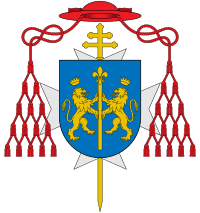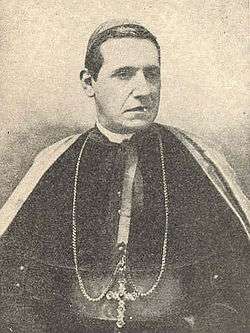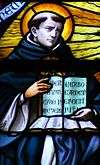Mariano Rampolla
| His Eminence Mariano Rampolla del Tindaro | |
|---|---|
| Official of the Congregation of the Holy Office | |
|
Rampolla around 1895 as Secretary of State under Pope Leo XIII | |
| Appointed | 30 December 1908 |
| Term ended | 23 February 1910 |
| Predecessor | Giuseppe Pizzardo |
| Successor | Donato Raffaele Sbarretti Tazza |
| Other posts |
|
| Orders | |
| Ordination | 1866 |
| Consecration |
8 December 1882 by Edward Henry Howard |
| Created Cardinal | 14 March 1887 |
| Rank | Cardinal-Priest |
| Personal details | |
| Birth name | Mariano Rampolla del Tindaro |
| Born |
17 August 1843 Polizzi Generosa |
| Died |
16 December 1913 (aged 70) Rome |
| Denomination | Roman Catholic |
| Previous post |
|
| Coat of arms |
 |
Mariano Rampolla del Tindaro (17 August 1843 – 16 December 1913) was an Italian Cardinal in the Roman Catholic Church.
During his tenure as Archpriest of Saint Peter's Basilica, Cardinal Rampolla was designated to canonically crown the venerated image of Santo Bambino of Aracoeli on 2 May 1897.
Early life
Born in Polizzi Generosa, Sicily, Rampolla was the son of Ignazio Rampolla, Count of Tindaro, and of his wife, Orsola Errante. He is often referred to with the title of marquess, but this appears to be inaccurate.
Rampolla entered the Vatican Seminary in 1856, and in 1861 continued his education at the Collegio Capranica and the Pontifical Gregorian University. Having displayed a considerable knowledge in Oriental affairs, he was sent to the Pontifical Academy of Ecclesiastical Nobles as preparation for service in the Roman Curia.
In 1866 Rampolla was ordained a priest. He obtained a doctorate in utroque iure (Canon Law and Civil Law)in 1870. In 1874 he was named a Canon of the Basilica di Santa Maria Maggiore. In 1875 he was sent to Spain as Auditor of the papal Nunciature. In 1877 he returned to Rome and was named Secretary for Oriental Affairs of the Congregation for the Propagation of the Faith. In the following year he was named a Protonotary apostolic de numero participantium, the highest rank of Monsignors. In 1880 he was named Secretary of the Congregation for the Propagation of the Faith, the Vatican office which deals with areas of the world in which there is no regularly constituted hierarchy of bishops. Then Rampolla was also appointed Secretary of the Congregation of Extraordinary Ecclesiastical Affairs, the subsection of the Secretariat of State which deals with the foreign affairs of the Holy See.
On 1 December 1882 Rampolla was appointed titular archbishop of Heraclea in Europa, and on 8 December 1882 was consecrated bishop by Cardinal Edward Henry Howard in the Vatican Basilica. This was in preparation for his nomination as Apostolic Nuncio to Spain, which came on 19 December 1882.[1]
Cardinal
| Styles of Mariano Rampolla del Tindaro | |
|---|---|
 | |
| Reference style | His Eminence |
| Spoken style | Your Eminence |
| Informal style | Cardinal |
| See | Heraclea in Europa (titular) |
In the Consistory of 14 March 1887, Pope Leo XIII created Rampolla del Tindaro a Cardinal-Priest, at the age of 43, and on 26 May formally assigned him the titulus of Santa Cecilia in Trastevere. On 2 June he was appointed Secretary of State. In this office (as previously in Spain), Rampolla employed Giacomo della Chiesa, the future Benedict XV, as his secretary.
As Secretary of State, Cardinal Rampolla supported the Austrian Christian Social Party, led by Karl Lueger, sometime mayor of Vienna (1897-1910). Lueger only entered office, over the disapproval of Emperor Franz Joseph, through the personal intervention of Leo XIII. Leuger's Christian Social Party was the first Catholic social movement that was both anti-liberal and anti-Semitic.[2] Rampolla began to swing papal policy away from support of Austria, come what may, toward support of France, Austria's enemy. His policy inside Italy, in the most general terms, was to oppose every Italian government that came to office, on the grounds that there was nothing to lose, and perhaps something to gain, especially on the international scene.[3]
On 21 March 1894, Pope Leo XIII named Cardinal Rampolla to be Archpriest of the Vatican Basilica. In 1908 he became Prefect of the Sacred Congregation of the Fabric of Saint Peter's.[4]
1903 Conclave veto

When Leo XIII died in 1903, it was widely expected that Rampolla would be elected pope. His candidacy gained momentum until the last moment when the Austrian Emperor Francis Joseph I, sovereign of one of the three major European Catholic nations claiming such power (Austria, France and Spain), imposed the veto Jus exclusivae during the Conclave. Cardinal Jan Puzyna de Kosielsko, Prince-Archbishop of Kraków, expressed the veto on behalf of the Austrian emperor. Cardinal Puzyna de Kosielsko was subsequently (1904) decorated with the Grand Cross of the Order of Saint Stephen of Hungary.[5]
The Secretary of the Conclave, Archbishop Rafael Merry del Val, reported later that Cardinal Puzyna de Kosielsko came to see him, demanding to announce his veto against Cardinal Rampolla in the name of Emperor Franz Joseph I of Austria. Merry Del Val protested and refused even to accept the document. Rampolla, according to Merry del Val, actually gained votes after the veto. However, Merry del Val later opined to Ludwig von Pastor that Rampolla was unlikely to win as a majority of the cardinals wanted a more conservative direction from the relatively liberal pontificate of Pope Leo XIII, as did he himself.[lower-alpha 1]
The specific reasons for Austria's opposition have never been clarified. Possibly, the veto was a result of the pro-French positions adopted by Rampolla, which were reflected in the policies of Leo XIII. Part of the Holy See's solution involving the French Republic was the attempt to reconcile French Catholics with their nation's republican government via Laïcité. This was anathema to the powerful Ultramontanes. Informed sources at the time also claimed that Austria acted on behalf of Italy's government through the intervention of State Minister Zanardelli.[7] Count Carl Lonyay, in his book Rudolf : the tragedy of Mayerling,[8] gives an explanation based on the murder/suicide of Franz Joseph's son, Crown Prince Rudolf in 1889. Rampolla was the Papal Secretary of State at the time of the Mayerling events, and he personally refused the dispensation which would allow Rudolf's burial in sacred ground, for which he incurred the undying enmity of the Emperor, who exacted his revenge fifteen years later by vetoing the Cardinal's election as Pope. The official reason for Rudolf's death, however, was "mental imbalance", which allowed for a Catholic burial.
While some prelates formally protested this intrusion after voting had been in progress, the Ultra Cardinals readily recognized the existing legal right of the emperor. Support for Rampolla dissipated, leading to the election of Giuseppe Sarto as Pope Pius X. Abolition of the veto right was one of the new Pope's first official acts.
Pius X
Pius X chose the able secretary of the conclave that had elected him, Rafael Merry del Val, to succeed Rampolla as Secretary of State. However, Rampolla remained Arch-Priest of Saint Peter's,[7] a position to which he had been appointed by Leo XIII. He lived in a modest house behind Saint Peter's Basilica. Between 1908 and his death in 1913, Rampolla served as Secretary (then the head) of the Supreme Sacred Congregation of the Holy Office. In 1912, Pope Pius X appointed Rampolla, in addition to his role as head of the Holy Office, as Archivist and Librarian of the Holy Roman Church, a position he held until his death.[9]
Symbolising successful papal diplomacy and worldwide contacts, he continued to be viewed as a most likely successor to Pope Pius X in case of the pontiff's death. Rampolla died suddenly in Rome on 16 December 1913 at age seventy, some months before the pope died in August 1914.[10] He was buried in the Campo Verano Cemetery, near the Basilica of S. Lorenzo fuori le mura.[11] His friend and closest collaborator, Giacomo della Chiesa, the future Pope Benedict XV, presided over his funeral ceremonies. On 19 June 1929, twelve days after the Italian Parliament ratified the Lateran Treaty, the body of Cardinal Rampolla was transferred to Santa Cecilia.
Notes
- ↑ Valérie Pirie claims that Rampolla would never have won in the conclave, and that all that the veto accomplished was to make him appear a sympathetic figure as a victim of Austrian hostility, "inasmuch as it gave his defeat the appearance of having been brought about by a treacherous knock-out blow, when in reality his failure was inevitable; the world at large being still convinced that had it not been for the Austrian veto Rampolla would certainly have been elected Pope."[6]
See also
References
| Wikimedia Commons has media related to Mariano Rampolla del Tindaro. |
- ↑ For this entire section, see the alphabetical entry in Bräuer, Handbuch der Kardinäle.
- ↑ Owen Chadwick, A History of the Popes, 1830-1914, p. 318-319.
- ↑ Owen Chadwick, A History of the Popes, 1830-1914, p. 305.
- ↑ S. Miranda, Congregation of the Reverend Fabric of Saint Peter's Basilica. Retrieved: 2016-03-21.
- ↑ Salvador Miranda. "The Cardinals of the Holy Roman Church - Consistory of April 15, 1901". Retrieved 2012-07-12.
- ↑ Valérie Pirie. "The Triple Crown: An Account of the Papal Conclaves - Concluding Chapter: Leo XIII and His Successors".
- 1 2 De Waal 30
- ↑ London : H. Hamilton, 1950
- ↑ The appointment of Librarian is disputed by S. Miranda, who shows two other Cardinals in that post at the time when Rampolla is supposed to have served.
- ↑ de Waal 31
- ↑ S. Miranda, Biographical notes on Cardinal Rampolla. Retrieved: 2016-03-21.
Bibliography
- Bräuer, Martin (2014). Handbuch der Kardinäle: 1846-2012. De Gruyter. ISBN 978-3-11-026947-5.
- Burkle-Young, Francis A. (2000). Papal Elections in the Age of Transition 1878-1922. Lanham: Lexington Books. ISBN 0-7391-0114-5.
- Cerami, Calogero. La figura e l'opera del cardinale Mariano Rampolla del Tindaro (Caltanissetta: S. Sciascia, 2006)[Storia e cultura di Sicilia, 19].
- Chadwick, Owen (2003). A History of the Popes, 1830-1914. New York-London: Oxford University Press. ISBN 978-0-19-926286-1.
- Frei, Peter. Die Papstwahl des Jahres 1903, unter besonderer Berucksichtigung des osterreichisch -ungarischen Vetos (Bern/Frankfurt a. Main 1977).
- Larkin, Maurice. Church and State after the Dreyfus Affair: The Separation Issue in France (New York: Harper & Row, Springer, 1974), 40-89; 117-133.
- Lonyay, Graf Karoly (1950). Rudolf; the tragedy of Mayerling. London: H. Hamilton.
- [Mathieu, Cardinal François Désiré]. Les derniers jours de Léon XIII et le Conclave, par un Temoin (Paris: Librarie Victor Lecoffre 1904), 98-115.
- Sinopoli di Giunta, G. Pietro. Il Cardinale Mariano Rampolla del Tindaro (Rome: Vatican Press, 1923).
- Pollard, John (20 June 2005). Benedict XV: The Unknown Pope and the Pursuit of Peace. London: A&C Black. ISBN 978-0-86012-408-5.
- Trincia, Luciano (2004). Conclave e potere politico: il veto a Rampolla nel sistema delle potenze europee, 1887-1904. Roma: Studium. ISBN 978-88-382-3949-6.
- Various (1967). The World Book Encyclopaedia:Q-R (Volume 16).
- Waal, Anton de (1915). Benedict XV. Hamm: Breer & Thiemann.
| Catholic Church titles | ||
|---|---|---|
| Preceded by Angelo Bianchi |
Nuncio to Spain 19 December 1882 - 2 June 1887 |
Succeeded by Angelo Di Pietro |
| Preceded by Luigi Jacobini |
Cardinal Secretary of State 2 June 1887 - 20 July 1903 |
Succeeded by Rafael Merry del Val |
| Preceded by Gaetano Aloisi Masella |
Camerlengo of the Sacred College of Cardinals 16 January 1893 - 18 May 1894 |
Succeeded by Fulco Luigi Ruffo-Scilla |
| Preceded by Francesco Ricci Paracciani |
Archpriest of St. Peter's Basilica 21 March 1894 - 16 December 1913 |
Succeeded by Rafael Merry del Val |
| Preceded by Serafino Vannutelli |
Secretary of the Supreme Sacred Congregation of the Holy Office 30 December 1908 - 16 December 1913 |
Succeeded by Domenico Ferrata |
| Preceded by Francesco Salesio Della Volpe |
Archivist of the Holy Roman Church 26 November 1912 - 16 December 1913 |
Succeeded by Francesco di Paola Cassetta |


